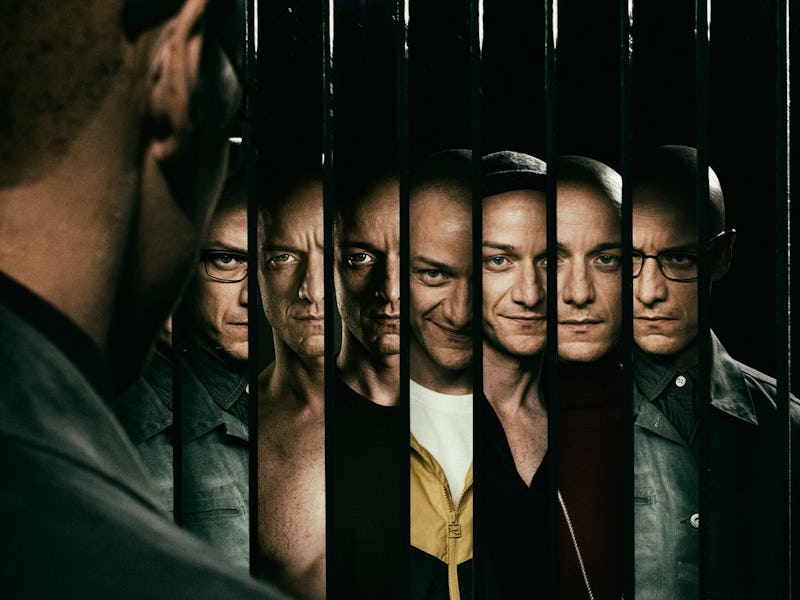M. Night's 'Unbreakable' Superhero Universe Uses These Tropes
After 'Split,' where will Shyamalan go with his superhero continuity?

In 2000, M. Night Shyamalan made an original superhero movie, and in 2017, he set Split in the same universe. Unbreakable’s realistic portrayal of what it would be like if a superhero walked among us was truly before its time. Released a few years after Blade, a few months before Bryan Singer’s X-Men, and a full eight years before Iron Man kicked off the Marvel Cinematic Universe, Unbreakable is proof that Shyamalan’s filmography borrows a great deal from superhero comics.
In the wake of Split’s success, Shyamalan has heavily hinted that he plans to continue his new superhero universe in future films. Keeping that in mind, here are the tropes that need to continue to keep his grounded take on superhuman abilities viable.
Secret Identities
Superhero comic book characters often create new identities to compartmentalize their vigilantism. In Unbreakable, David Dunn (Bruce Willis) comes to realize that his powers are some kind of muted mix of Superman and Professor X, and his first act as a superhero is confronting and stopping a rapist, Orange Man. Instead of trumpeting to the world that he’s the savior, he simply shows his son a newspaper article about the heroic act to prove his power as a kind of reluctant superhero. Kevin (James McAvoy) from Split is literally in the act of becoming, and he shifts through his identities as a way to mask his final form: the Beast.
From Trauma to Empowerment
Trauma is perhaps the most important theme in Shyamalan’s work overall. It’s what gives Cole the ability to see ghosts in The Sixth Sense, gives Father Hess his leap of faith in Signs, and informs the big modern twist in The Village.
It’s much more literal in Unbreakable: Surviving the train crash perpetrated by Mr. Glass (Samuel L. Jackson) is what creates David Dunn’s own self-realization. An abusive mother is what sets Kevin off into his multiple personalities in Split. Dr. Fletcher even hints in her research that traumatic circumstances could unlock untapped superpowered potential.
Personal trauma is often what gives a comic book superhero their drive, if not their literal powers, be it Bruce Wayne witnessing the deaths of his parents or Peter Parker not being able to save Uncle Ben. Recovering from a horrible act is the catalyst behind these stories, and Shyamalan seems to be infatuated with figuring out where the separation between people choosing to be a hero or a villain lies.
Heroes Creating Villains
Personal trauma also feeds into the symbiotic relationship between the most upstanding heroes in comic books and their villains. A hero often creates his own arch-nemesis, inadvertently inspiring acts of villainy once he or she goes public. Unbreakable subverts this trope when Mr. Glass creates disasters as a way to coax people with potential powers from out of hiding. The same codependent relationship is twisted at the end of Split. Sitting in a diner and watching what will happen because of the Horde is hopefully what will persuade David Dunn to take action in future films.
Unsuspecting Weaknesses
Everybody has their own version of Kryptonite. The stone has become a versatile symbol over time, and one that Shyamalan knows has to be much more authentic in his grounded story. In Unbreakable and Split, these things can’t be glowing radioactive pieces of someone’s exploded homeworld. Instead they’re true to the backstories of each character but equally unexpected.
When David picks his son Joseph up from school after he was in an altercation with a bully, a nurse remembers the grownup David as a kid who once almost drowned in the school pool. Later, David nearly drowns again when the Orange Man pushes him off a balcony into an inground pool below. Similarly, Dr. Fletchers scrawled note about saying Kevin Wendell Crumb’s real name is what helps Casey temporarily incapacitate his Beast persona. If these characters ever get to clash, these crippling weaknesses need to emerge organically.
Superhero Monikers
Shyamalan runs with the idea that superheroes need names suitable for their superhuman prowess. David Dunn doesn’t have one, though his alliterative first and last name go hand in hand with the comic book world’s tendency to double up on similar sounding names for characters like Bruce Banner, Peter Parker, Reed Richards, or J. Jonah Jameson.
Instead, Shyamalan has mostly kept the monikers to his villains. Mr. Glass’s name is tied to his personal history — he was mercilessly teased as a kid and given that name because of the genetic disorder that left his bones extremely brittle. At the end of Split, we hear in a news report that police are calling the suspected killer, who is the combined result of Kevin’s dominant personalities, “The Horde.” This borders on silliness, but then again the media is always quick to label killers with catchy names, from Jack the Ripper to the Boston Strangler. Perhaps a continuation of Shyamalan’s series will culminate in David getting his own superhero name.
An Avengers-esque Team Up
Split more than suggests that Shyamalan is building towards some sort of climactic meeting of superhumans living among us, so it would be an incredible feat to pull of some kind of Avengers-esque culmination in Shyamalan’s multi-movie cycle. Considering David Dunn’s good guy is outnumbered by Mr. Glass and the Horde, it’s possible that he’ll have to fend off a collective of villains instead. Maybe we’ll see Shyamalan’s own iteration of the Sinister Six in the next films. We can see it now: Mr. Glass breaks free of the Arkham-like mental hospital where he’s being kept and recruits his own supervillain troupe with the Horde as a way to lure David Dunn out of exile.